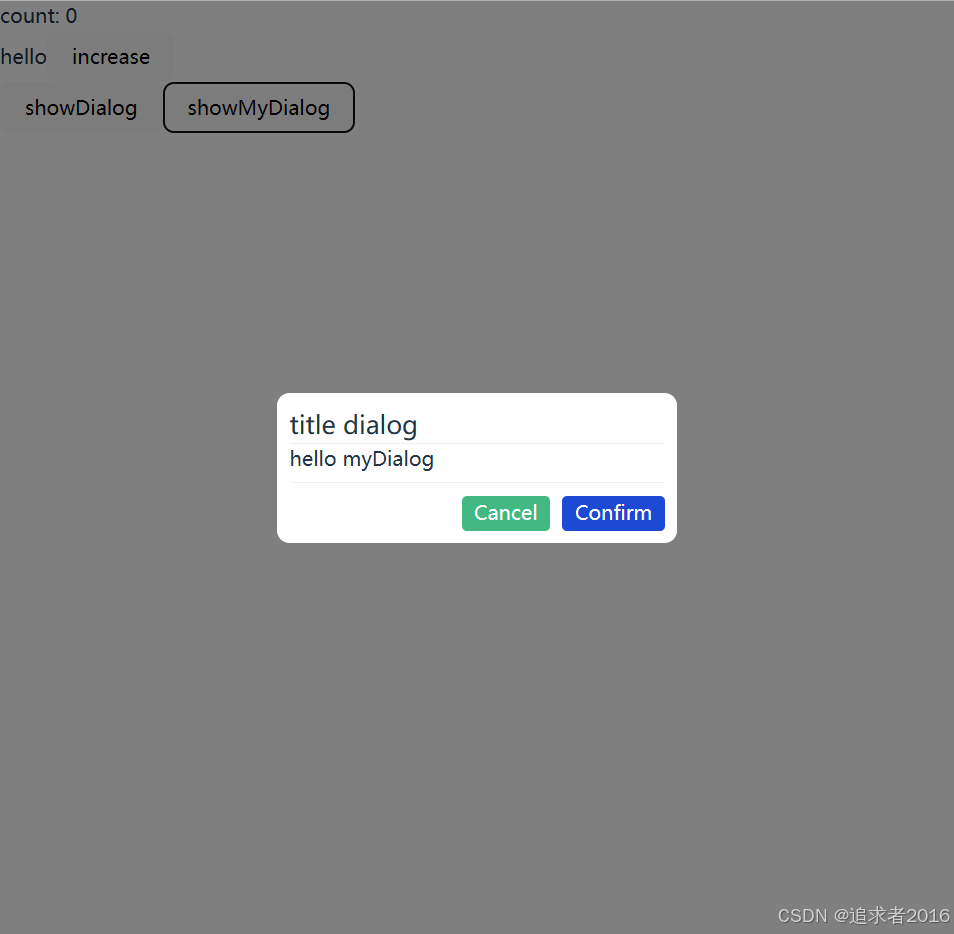缘由:项目要用到一个弹框,需要公共函数内调用。考虑封装成像 Element Plus 的 ElMessageBox.confirm 的方式调用,而不是直接在 template 中写组件的方式调用。
最小实现效果:


思路逻辑
实现
实现弹框 component
<template>
<el-dialog
v-model="visible"
width="480"
:title="props.title"
:close-on-click-modal="false"
@close="onClose()"
@open="onOpen()"
>
<template #default>
<el-form ref="formRef" :model="formData" inline-message label-width="120px">
<template v-for="(item, index) in formData.barcodeList" :key="index">
<el-form-item
:label="`${$t('common.label')}(${index + 1})`"
:prop="`barcodeList.${index}.barcode`"
:rules="getRule(index)"
>
<div class="w-full flex items-center">
<el-input v-model="item.barcode"></el-input>
<el-button
v-if="index !== 0"
class="flex-center ml-10"
type="plain"
size="small"
circle
@click="onDelete(index)"
>
<i class="iconfont icon-delete ml-4 error-color"></i>
</el-button>
</div>
</el-form-item>
</template>
</el-form>
<el-button type="primary" @click="addNewBarcode()">{{ $t('common.addBarCode') }}</el-button>
</template>
<template #footer>
<div class="dialog-footer">
<el-button @click="onClose()">{{ $t('common.cancel') }}</el-button>
<el-button type="primary" @click="submitForm(formRef)">
{{ $t('common.confirm') }}
</el-button>
</div>
</template>
</el-dialog>
</template>
<script setup lang="ts">
import { ElMessage, FormInstance, FormRules } from 'element-plus'
import { computed, reactive, ref, PropType } from 'vue'
import { useI18n } from 'vue-i18n'
const { t: $t } = useI18n()
defineOptions({
name: 'CompleteDialog',
})
const props = defineProps({
message: String,
title: String,
onOpen: Function as PropType<() => void>,
onCancel: Function as PropType<() => void>,
onConfirm: Function as PropType<(data: any) => void>,
})
const emits = defineEmits(['submit'])
const visible = defineModel({ type: Boolean, default: false })
const formRef = ref<FormInstance>()
const formDataDefault = {
barcodeList: [
{
barcode: '',
},
] as any[],
}
const formData = reactive<typeof formDataDefault>({ ...formDataDefault })
const formRules = reactive<FormRules>({})
const getRule = (index?: number) => {
return [{ required: true, message: $t('common.RequiredInput'), trigger: 'change' }]
}
const onDelete = (index: number) => {
formData.barcodeList.splice(index, 1)
}
const addNewBarcode = () => {
const len = formData.barcodeList.length
formData.barcodeList.push({ barcode: '' })
}
const onOpen = () => {
const { onOpen } = props
if (onOpen) {
onOpen()
}
}
const onClose = () => {
const { onCancel } = props
if (onCancel) {
onCancel()
}
formRef.value?.resetFields()
Object.assign(formData, formDataDefault)
visible.value = false
}
const submitForm = async (formEl?: FormInstance) => {
if (!formEl) return
await formEl.validate(async (valid: any) => {
if (!valid) return false
const result = { ...formData }
emits('submit', result)
if (props.onConfirm) {
props.onConfirm(result)
}
onClose()
})
}
</script>
<style lang="scss" scoped></style>
封装函数方式调用 index.tsx
因为用了 sx ,所以没有用 h 函数.如果没有用 jsx,需要用 h 函数创建 VNode
import { i18n, locale } from '@/lang/index'
import { createApp, ref, watch } from 'vue'
import ElementPlus from 'element-plus'
import CompleteDialog from './completeDialog.vue'
export const useConfirmCompleteDialog = <T extends any>(
message?: string,
title?: string
): Promise<T> => {
return new Promise((resolve, reject) => {
const div = document.createElement('div')
document.body.appendChild(div)
const app = createApp({
setup() {
const visible = ref(true)
const close = () => {
visible.value = false
}
const onConfirm = (data: any) => {
resolve(data)
close()
}
const onCancel = () => {
reject()
close()
}
watch(visible, newValue => {
if (!newValue) {
app.unmount()
document.body.removeChild(div)
}
})
return () => (
<CompleteDialog
modelValue={visible.value}
onUpdate:modelValue={value => {
visible.value = value
}}
message={message}
title={title}
onConfirm={onConfirm}
onCancel={onCancel}
></CompleteDialog>
)
},
})
// 因为项目用了 i18n 国际化, ElementPlus UI组件,所以引入
// 根据实际项目需要修改,不需要i18n,ElementPlus的可以取消,只需要注册自定义组件
app.use(i18n).use(ElementPlus, { locale })
app.component(CompleteDialog.name, CompleteDialog)
app.mount(div)
})
}
最小化实现:
vim myDialog/myDialog.vue
<template>
<div v-if="visiable" class="my-dialog">
<div class="mask" @click="onCancel"></div>
<div class="dialog-content">
<div class="dialog-title">{{ props.title }}</div>
<div class="dialog-body">
<div>{{ props.message }}</div>
<slot>
</slot>
</div>
<div class="dialog-footer">
<div class="btn btn-cancel" @click="onCancel">Cancel</div>
<div class="btn btn-confirm" @click="onConfirm">Confirm</div>
</div>
</div>
</div>
</template>
<script setup lang="ts">
import { PropType } from 'vue'
const props = defineProps({
title: {
type: String,
default: 'Dialog Title'
},
message: String,
onOpen: Function as PropType<() => void>,
onCancel: Function as PropType<() => void>,
onConfirm: Function as PropType<(data?: any) => void>,
})
const visiable = defineModel()
const onOpen = () => {
props?.onOpen()
}
const onCancel = () => {
props?.onCancel()
}
const onConfirm = () => {
props?.onConfirm()
}
</script>
<style lang="scss" scoped>
.my-dialog {
position: fixed;
top: 0;
left: 0;
right: 0;
bottom: 0;
}
.mask {
position: absolute;
top: 0;
left: 0;
right: 0;
bottom: 0;
background-color: rgba(0, 0, 0, 0.5);
}
.dialog-content {
position: absolute;
top: 50%;
left: 50%;
transform: translate(-50%, -50%);
min-width: 300px;
min-height: 100px;
display: flex;
flex-direction: column;
justify-content: space-between;
background-color: #fff;
padding: 10px;
border-radius: 10px;
}
.dialog-title {
flex: 0 0 30px;
font-size: 20px;
border-bottom: 1px solid #eee;
}
.dialog-body {
flex: 1;
min-height: 24px;
}
.dialog-footer {
display: flex;
justify-content: flex-end;
align-items: center;
padding: 10px 0 0;
border-top: 1px solid #eee;
}
.btn {
color: #fff;
padding: 2px 10px;
border: 1 solid #fff;
border-radius: 4px;
cursor: pointer;
}
.btn + .btn {
margin-left: 10px;
}
.btn-cancel {
background-color: #42b983;
&:hover {
background-color: #8ce6c2;
}
}
.btn-confirm {
background-color: #1d4ad4;
&:hover {
background-color: #8fa7f6;
}
}
</style>
vim myDialog/index.tsx
import { createApp, ref, watch } from 'vue'
import MyDialog from './myDialog.vue'
export const useConfirmDialog = <T extends any>(
message?: string,
title?: string
): Promise<T> => {
return new Promise((resolve, reject) => {
const div = document.createElement('div')
document.body.appendChild(div)
const app = createApp({
setup() {
const visible = ref(true)
const close = () => {
visible.value = false
}
const onConfirm = (data: any) => {
close()
return resolve(data)
}
const onCancel = () => {
close()
return reject()
}
watch(visible, newValue => {
if (!newValue) {
app.unmount()
document.body.removeChild(div)
}
})
return () => (
<MyDialog
modelValue={visible.value}
onUpdate:modelValue={value => {
visible.value = value
}}
message={message}
title={title}
onConfirm={onConfirm}
onCancel={onCancel}
></MyDialog>
)
},
})
app.component(MyDialog.name, MyDialog)
app.mount(div)
})
}
demo调用
<template>
<div>
<button @click="showMyDialog">showMyDialog</button>
</div>
</template>
<script setup lang="ts">
import { useConfirmDialog } from './myDialog'
function showMyDialog() {
useConfirmDialog('hello myDialog', 'title dialog').then(() => {
console.log('myDialog confirm')
}).catch(() => {
console.log('myDialog cancel')
})
}
</script>




















 1696
1696

 被折叠的 条评论
为什么被折叠?
被折叠的 条评论
为什么被折叠?








